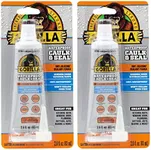Buying Guide for the Best Decorators Caulks
When it comes to choosing the right decorator's caulk, it's important to understand the different specifications and how they can impact your project. Decorator's caulk is used to fill gaps and cracks, providing a smooth finish before painting or wallpapering. The right caulk can make a significant difference in the final appearance and durability of your work. Here are some key specifications to consider when selecting decorator's caulk.Material TypeDecorator's caulk can be made from various materials such as acrylic, silicone, or latex. Acrylic caulk is easy to apply and clean up, making it a popular choice for indoor projects. Silicone caulk is more flexible and durable, ideal for areas exposed to moisture like bathrooms and kitchens. Latex caulk is paintable and offers good adhesion, suitable for most general-purpose applications. Choose the material type based on the specific needs of your project, considering factors like exposure to moisture and the need for paintability.
FlexibilityFlexibility refers to the caulk's ability to expand and contract with temperature changes and movement in the building materials. High flexibility is important for areas that experience significant movement, such as around windows and doors. Less flexible caulks are suitable for more stable areas like baseboards and crown molding. Assess the movement in the area where you will be applying the caulk to determine the level of flexibility required.
Drying TimeDrying time is the period it takes for the caulk to fully cure and be ready for painting or exposure to moisture. Fast-drying caulks can be painted over within a few hours, making them ideal for quick projects. Standard drying caulks may take 24 hours or more to cure, which is suitable for less time-sensitive tasks. Consider your project timeline and choose a caulk with a drying time that fits your schedule.
PaintabilityPaintability refers to the caulk's ability to be painted over once it has dried. Some caulks are specifically designed to be paintable, allowing you to achieve a seamless finish with your chosen paint color. Non-paintable caulks are typically used in areas where painting is not required. If you plan to paint over the caulk, ensure you select a paintable option to avoid any issues with adhesion or finish.
AdhesionAdhesion is the caulk's ability to stick to different surfaces. Good adhesion ensures that the caulk stays in place and provides a long-lasting seal. Some caulks are formulated to adhere better to specific materials like wood, metal, or plastic. Evaluate the surfaces you will be working with and choose a caulk that offers strong adhesion to those materials for the best results.
Mold and Mildew ResistanceMold and mildew resistance is an important feature for caulks used in damp or humid environments, such as bathrooms and kitchens. Caulks with this property help prevent the growth of mold and mildew, maintaining a clean and healthy environment. If you are working in areas prone to moisture, opt for a caulk with mold and mildew resistance to ensure longevity and hygiene.





















